A stroll around Peramola
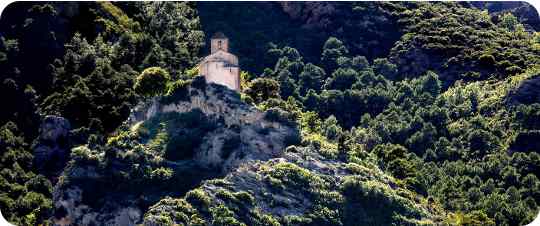 Castell-llebre
Castell-llebre
Prehistoric...
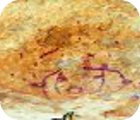 The cave paintings of El Roc of El Roc de Rumbau, also known as Roca dels Moros.
The cave paintings of El Roc of El Roc de Rumbau, also known as Roca dels Moros.
The cave paintings of El Roc de Rumbau, also known as Roca dels Moros.
Cave with abstract manifestations by Neolithic groups (from 6,500-3,500 years ago), known as Schematic Art. Its value as an expression of human intellectual capacity was ratified when it was awarded World Heritage status by UNESCO (1998). It has also been recognised as a Cultural Asset of National Interest -Archaeological zone (BCIN).
Location: in the direction of Castell-llebre – Hotel Can Boix.
Information and visits: free visit..
Romanesque...
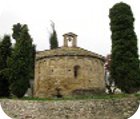 Sant Miquel de Peramola Vell, 11th
Sant Miquel de Peramola Vell, 11th
In the eleventh century, Peramola belonged to the knight Arnau Mir de Tost. Later, the town’s castle was the centre of the barony of Peramola, a noble jurisdiction that covered virtually the whole of the current municipality.
The church comprises a single nave and has a barrel vault roof. The apse features Lombard arch decoration and the main door has a semicircular arch with voussoirs.
Location: Peramola.
Information and visits: free visit. See the "Romanesque way of Alt Urgell"
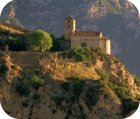 Mare de Déu de Castell-llebre, 11-12th
Mare de Déu de Castell-llebre, 11-12th
The building comprises a single nave with a barrel vault roof. It has a semicircular apse above which there is a pair of windows. The main door is decorated with a voussoired arch. It has an adjacent square ground-plan bell tower with a pyramidal roof.
Location: Castell-llebre.
Information and visits: free visit. See the "Romanesque way of Alt Urgell"
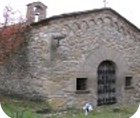 Santa Llúcia de Nuncarga & Tragó, 11th
Santa Llúcia de Nuncarga & Tragó, 11th
This building comprises a single nave with a central apse and two lateral apsidal chapels. They are decorated with Lombard arches and with a window in the centre. It has a barrel vault roof and a wall bell tower.
Location: Tragó.
Information and visits: free visit. See the "Romanesque way of Alt Urgell"
Sant Martí de Cortiuda
Location: Tragó.
Information and visits: free visit.
Sant Salvador del Corb
This is the smallest Romanesque church in Catalonia and today lies in ruins.
Location: Tragó.
Information and visits: free visit.
Remains of the old bridge of Peramola
The bridge was blown up in 1939. It was a twelfth-century construction that measured approximately 14 metres long. Located nearby are the remains of another bridge, known as the bride of Mala Muller, which was built at the end of the twelfth century.
Location: near the Oliana reservoir (ruins).
The castle of Peramola
In 1071 it belonged to Guerau de Cabrera. This castle was the administrative centre of the barony of Peramola. Today the remains of the castle are preserved under Cal Rincón and the Bar Casino.
Location: in Peramola .
Information and visits: free visit.
Other periods...
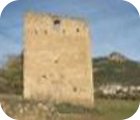 Torre dels moros (Moors' Tower), 16 th
Torre dels moros (Moors' Tower), 16 th
This is a square ground plan tower, the sides of which measure 5.40 metres and the walls of which are one metre thick.
Location: before reaching Peramola, take the new road that heads southwards. The tower is on the left, some five hundred metres from the village, just past the stream.
Information and visits: free visit.
Chapel of the Roser of Peramola, 16th
Quadrangular ground plan building with a barrel vault and a hip roof.
Location: Peramola.
Information and visits: free visit.
Hermitage of Sant Honorat, 18th
Rectangular ground plan building, with no differentiated chevet, practically demolished.
Location: Sant Honorat.
El Roser de la Móra de Cortiuda.
A compact single-nave, rectangular ground plan church with no differentiated apse. East-facing.
Location: Cortiuda.
 Sant Miquel Nou, 16th
Sant Miquel Nou, 16th
This church is a clear example of a building that has been restructured and transformed over time. It has a rectangular ground plan and comprises a central nave with flat presbytery and two side naves. Its structure is complex on account of the church’s location and the fact that the right wall of the church’s façade was formerly part of Peramola’s town wall. In the late seventeenth century considerable alterations were made to the existing Gothic church. These affected the chevet, where Baroque style changes were made, and the roof, site of the body. In the twentieth century, the church’s current door and bell tower were opened.
Location: Plaça de l'Església - Peramola.
Information and visits: free visit.












